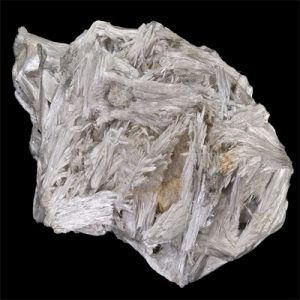Tremolite
Tremolite is a relatively common mineral but rare as a faceted gem. Most mineral specimens are fibrous, granular or columnar aggregates and not suitable for faceting. The crystals that are transparent, clean and brightly colored are very rare. Tremolite is a member of the Calcic Clino-Amphibole Subgroup of the Amphibole Group of minerals that includes Actinolite, Ferro-edenite, Kaersutite, Pargasite, Richterite and Tremolite. The Amphibole Group is an extensive and complex group of minerals currently divided into several sub-groups. Gem quality Tremolite gets its vivid green coloring from the iron (Fe) content. A pale lilac to purplish color variety of Tremolite is called Hexagonite and is colored by manganese (Mn). A green chromium (Cr) rich variety called Chrome Tremolite is found mainly in the Merelani Hills of Tanzania.
Tremolite was named by J.G.A. Höpfner for the Tremola valley (Val Tremola), Central St Gotthard Massif, Switzerland, where the type material supposedly came from, according to the dealer from whom he had acquired the specimens. Though, modern investigations of what is considered the type material, conserved at Geneva, revealed that the type locality is actually Campolungo. Val Tremola lying north of the isograde delineating the first appearance of Tremolite.
The only notable sources of gem quality crystals of Tremolite are Harcourt, Haliburton County, Ontario, Canada; Outokumpu, Itä-Suomen Lääni, Finland; Umba Valley region, Kenya; Northern Areas, Astor District Astor, Pakistan;Merelani Hills (Mererani), Lelatema Mts, Simanjiro District, Manyara Region, Tanzania. In the USA, from Pierrepont, Gouverneur, Edwards, and Macomb, St. Lawrence County, New York; at Franklin, Sussex County, New Jersey; and Lee, Berkshire County, Massachusetts.
| Chemical Formula: | Ca2(Mg;Fe2+)5Si8O22(OH)2 |
| Calcium Magnesium Iron Silicate Hydroxide | |
| Molecular Weight: | 812.37 gm |
| Composition: | Calcium | 9.87 % | Ca | 13.81 % | CaO |
| Magnesium | 14.96 % | Mg | 24.81 % | MgO | |
| Silicon | 27.66 % | Si | 59.17 % | SiO2 | |
| Hydrogen | 0.25 % | H | 2.22 % | H2O | |
| Oxygen | 47.27 % | O | |||
| 100.00 % | 100.00 % | = TOTAL OXIDE |
| Crystallography: | Monoclinic – Prismatic |
| Crystal Habit: | Elongated, stout prismatic, or flattened bladed crystals, to 20 cm; also fibrous, granular or columnar aggregates. |
| Twinning: | Simple or multiple, common || {100}; rarely multiple || {001} |
| Cleavage: | Perfect on [110]; partings on [010], [100] |
| Fracture: | Sub-Conchoidal |
| Tenacity: | Brittle |
| Moh’s Hardness: | 5.0 – 6.0 |
| Density: | 2.99 – 3.03 (g/cm3) |
| Luminescence: | Fluorescent; SW UV = yellow, LW UV = pink |
| Radioactivity: | Not Radioactive |
| Health Warning: | Asbestiform varieties of Tremolite can cause lung disease when inhaled, as with other species of asbestos minerals. |
| Color: | White, Brown, Gray, Colorless, light to dark Green, light Yellow, Pink to Violet; colorless in thin section |
| Transparency: | Transparent to Translucent, Opaque |
| Luster: | Vitreous, Silky |
| Refractive Index: | 1.599 – 1.637 Biaxial ( – ) |
| Birefringence: | 0.0250 – 0.0260 |
| Dispersion: | Weak; r < v |
| Pleochroism: | None |


